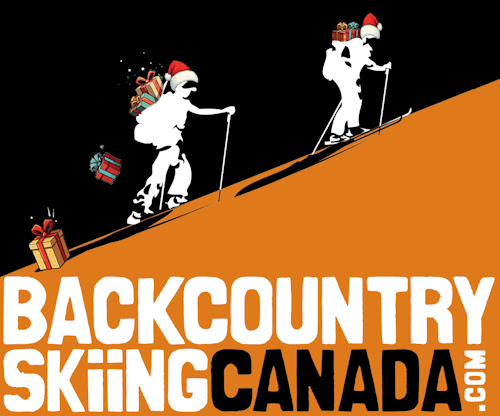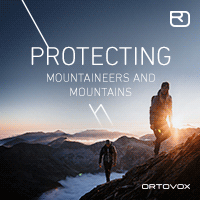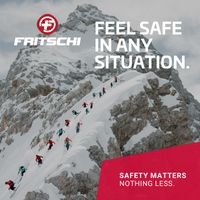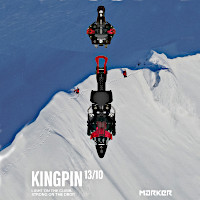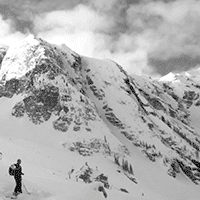Shovelling Success Story
From our good friends at Backcountry Access:
It may sound fundamental, but shoveling education is an important new frontier in avalanche education. Teaching shoveling techniques can make the difference between life and death when students are involved in a rescue—especially when the burial is deep.
A success story near Fernie, British Columbia illustrates that learning to shovel properly can indeed save a life. In this case, a 23 year old snowboarder was recovered alive after a large slab avalanche buried him two meters deep. The rescuers attribute their successful rescue to an extremely fast beacon search and the shoveling techniques they learned one month before in a recreational avalanche course. This case study provides evidence that shoveling education truly pays off in recreational avalanche courses.
Introduction
On January 7, 2008, Todd Weselake, Janina Kuzma, and Ian Bezubiak were backcountry touring in Cold Feet Bowl on Mt. Proctor in the Kootenay Range in interior British Columbia. Snowboarder Weselake, 23, was buried at least two meters deep in a slab avalanche that ran 200 meters wide, 400 meters long, and with an average slab depth of 150 centimeters. He was located with an avalanche transceiver, detected with a probe, and extricated by skiers Bezubiak and Kuzma, both 22. Despite the depth of burial, Weselake was recovered alive. All three members of the party attribute this success mainly to the shoveling techniques they learned at a Canadian Avalanche Centre (CAC) Avalanche Skills Training (AST) avalanche course one month before the accident occurred.
 |
The avalanche crown, flanks and debris pile are outlined in the image. The arrow points to the excavation area. |
Rescue Summary
All phases of the rescue were performed efficiently, especially the transceiver search and excavation phases. The incident took place during considerable avalanche hazard at that elevation and aspect, according to Canadian Avalanche Centre (CAC) bulletins. At the time of the release, the party was moving one at a time between points of safety after having seen several signs of instability during their initial descent, including a smaller slab avalanche just ten minutes before the incident. Both Weselake and Bezubiak were involved in the slide when it released; Bezubiak escaped the moving debris by grasping a tree. Kuzma was just above the crown when the avalanche occurred. Bezubiak performed a hasty search, looking for physical signs of Weselake and attempting to pick up his transceiver signal. Once the signal was acquired, Kuzma performed the secondary and pinpoint search while Bezubiak prepared shovels and probes. The two used various probing techniques to confirm the location and depth of the victim, whose helmet was struck two meters beneath the snow surface.
The beacon search was the easiest part of the rescue, according to both rescuers, consuming less than 15 percent of the overall rescue time. The probing phase was complicated by equipment problems, but eventually was consummated using a widely taught “spiral probing” technique. The shoveling phase was the most difficult, as the snow was dense and the victim was deep. The two dug a starter hole together, beginning two to three meters downhill of the probe. When Kuzma became exhausted, they rotated, with Bezubiak now shoveling blocks of snow to Kuzma, who then shoveled it clear of the hole. When Bezubiak reached Weselake, he cleared snow from the victim’s face and chest. Once his chest was freed, Weselake gradually regained consciousness. The rescuers took approximately 15 minutes to extricate the rest of his body. At this time, Weselake was able to walk away from the excavation area.
The overall rescue time was approximately 20 25 minutes: 3 minutes for the transceiver search, 5 minutes to probe, and 15 20 minutes to excavate.
 |
By starting the excavation well downhill of the probe strike, the rescuers were able to access and extricate Weselake from the side without compromising his air pocket. Bezubiak extricates Weselake’s legs while the victim regains consciousness. |
Shoveling Education and Technique
This incident reinforces the importance of teaching strategic probing and shoveling technique in avalanche courses. In burials of this depth, the odds of survival are less than ten percent, according to CAC statistics (Jamieson, 2007). This is mainly due to the time required to excavate snow at this depth, as well as the enormous pressures that decrease the permeability of the snowpack and limit the ability to expand the chest, even if an air pocket is present. Previous research (Edgerly, 2006) has concluded that transceiver technology and education have improved dramatically in the past decade, driving down average rescue times for transceiver searches. However, this literature also proposes that advances in shoveling technique and education now stand to drive rescue times down even more, as this phase is vastly more time consuming. In the literature, two methods, sharing common themes, have been proposed: “strategic shoveling” (Edgerly et. al., 2006) and the “V–shaped conveyor” method (Genswein et. al., 2008).
In this case study, the rescuers used techniques that are common to both methods: 1) leaving the probe in place and starting the excavation downhill of the victim; 2) creating a large starter hole of a length one to two times the burial depth and approximately one “wingspan” wide; 3) one shoveler chopping and moving snow in a deep burial as the other clears it from the hole; and 4) creating a platform downhill of the victim that can be used for first aid and evacuation.
 |
Excavation is a critical phase in all avalanche rescues. Strategic shoveling should be taught in avalanche courses in addition to basic transceiver technique. |
The rescuers had read papers on strategic shoveling and learned the V-shaped conveyor method at a Mountain Pursuits CAC Level 1 AST course in Fernie, B.C. They used techniques common to both methods. In addition, there were several details not commonly taught in avalanche courses that helped to make a difference:
Extra gloves/supplies
In this incident, Bezubiak lost his gloves while assembling shovels and probes. Kuzma provided him with an extra pair. It is common for rescuers to remove their gloves during a rescue. This is a mistake; gloveless hands quickly become cold and ineffective while shoveling. Instructors should teach students to keep their gloves on at all times and to carry spares. The group also had clothing and hot drinks to keep Weselake warm during the evacuation.
Adequate Manpower
It is unlikely that Weselake would have survived if only one rescuer had been available for shoveling. It is also unlikely he and Bezubiak both would have survived if Bezubiak hadn’t escaped the slide at the beginning, as only Kuzma would have remained to excavate two victims. A recent study of avalanche incidents in France (Jarry, 2008) illustrates that shoveling manpower and technique are even more important than transceiver technology in the success of a rescue.
Good Communication
This group was particularly effective because they were close friends who communicated well during the tour and the rescue. This included checking equipment and discussing contingencies at the trailhead. They carried cell phones and notified rescue authorities when they had service. This aided in Weselake’s evacuation and fast recovery.
Conclusion
Shoveling technique has increasingly made its way into North American recreational avalanche courses. That's for a good reason: excavation takes the majority of time and energy in a transceiver rescue. Techniques such as “strategic shoveling” and the “V-shaped conveyor” save valuable time and create a better workspace for extricating, reviving, and treating the victim. This case study illustrates the importance of teaching not only basic transceiver rescue in avalanche courses, but also efficient probing and shoveling techniques. The increasing emphasis on shoveling and probing education in North America is now proving itself as a valuable tool for saving lives.
References
Edgerly, B. and Atkins, D., “Strategic Shoveling: The Next Frontier in Companion Rescue.” ISSW Proceedings 2006.
Genswein, M. and Eide, R.,” V-Shaped Conveyor Belt Approach to Snow Transport.” The Avalanche Review. February 2008.
Jamieson, B. and Geldsetzer, T., Avalanche Accidents in Canada. Volume 4: 1984 - 1996, supplemented 2007.
Jarry, F., “Qu’est-ce qu’on Creuse?” Neige et Avalanches. April 2008.
